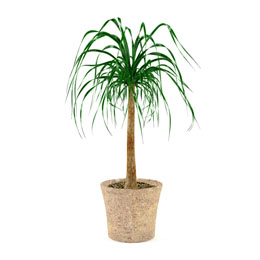Maintaining a ponytail palm plant is easy as it grows well in warm and dry conditions with moderate fertility. The following section gives more information about this plant and its care.

The ponytail palm is a highly appreciated landscaping plant which can also be maintained indoors. Despite the name, it is not related to any species of the palm family,
Palmaceae. On the contrary, it shares a taxonomic family with the lilies, and is a genus of
Liliaceae. Due to its shape, it has been given other names such as bottle palm or elephant's foot. Bulbous at the base and tapering towards the top with long and smooth foliage, it is very different from other ornamental trees.
Tips for Ponytail Palm Plant Care
Indigenous to the warm regions of Mexico, ponytail palm is best suited for growing as a houseplant. It is tolerant to the warm, heated conditions of the indoor environment. While planting it outdoors, select a sunlit area that has no water draining problems. The two main factors that negatively affect this tropical palm are--too much watering and standing in water for an extended period. The reason being that it is a type of succulent plant.
Grows in Sandy Soil
This tree is best grown in a soil type that is well-drained and contains sand components in a large percentage. Sandy soil allows easy draining of water, which is crucial for healthy maintenance of the plant. Reduce the use of peat moss and water-holding components as is usually done for growing tropical plants. This organic matter increases water retention, which is not good for this plant. In short, prepare a soil mixture in such a way that it resembles that of its natural habitat.
Very Less Watering
Water deeply and less frequently instead of irrigating this plant everyday. Frequent irrigation is strictly not recommended for maintaining it. It has a natural tendency to store water in the base, and this portion of the stem acts as a water reservoir. If you are not sure about the frequency of irrigation that is ideal for this palm, allow the top soil layer to dry out completely before the next watering.
Warm Temperature is Excellent
As this is a tropical plant, it requires warm climatic conditions. For growing as a part of indoor gardening, place the palm tree in your patio, where it receives optimal sunlight. In case of outdoors, you can place it in any sunlit area. However, exposure to cold winter temperature for a long period may kill the plant. Hence, with the arrival of winter, or dropping of the environment temperature below 55° Fahrenheit, bring the plant inside the house.
Repot to Grow Big
It is true that the size of the tree can be controlled by growing it in specific sized pots. In its natural habitat, the roots of the plant develop in a profuse form. Hence, container gardening of this tropical plant can be done in a smaller pot with less soil. In such cases, the growth rate is slow and the plant size is smaller. In case you prefer a taller tree, consider re-potting it in a larger container.
Watch for Diseases and Pests
This tropical plant is resistant to drought and withstands dry garden soil conditions for a long time, while excess water induces root rotting problems. If you notice bugs and mites, pick them manually and discard them in soapy water. An effective control measure is to soak cotton balls with a dish soap solution and use it to clean the affected parts.
When favorable growth requirements are provided, the ponytail palm tree grows to a height of about 20 feet. Provide this tropical plant with the necessary living conditions and there will be fewer incidences of pests and related plant problems. A simple tip is to keep the water level minimal and consider watering it every alternate week, and every 2 weeks in cold conditions.






 The ponytail palm is a highly appreciated landscaping plant which can also be maintained indoors. Despite the name, it is not related to any species of the palm family, Palmaceae. On the contrary, it shares a taxonomic family with the lilies, and is a genus of Liliaceae. Due to its shape, it has been given other names such as bottle palm or elephant's foot. Bulbous at the base and tapering towards the top with long and smooth foliage, it is very different from other ornamental trees.
The ponytail palm is a highly appreciated landscaping plant which can also be maintained indoors. Despite the name, it is not related to any species of the palm family, Palmaceae. On the contrary, it shares a taxonomic family with the lilies, and is a genus of Liliaceae. Due to its shape, it has been given other names such as bottle palm or elephant's foot. Bulbous at the base and tapering towards the top with long and smooth foliage, it is very different from other ornamental trees.